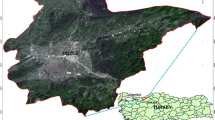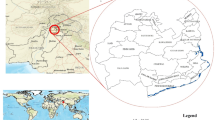Abstract
Land surface temperature is one of the most important parameters related to global warming. It depends mainly on soil type, discontinuous vegetation cover, or lack of precipitation. The main purpose of this paper is to investigate the relationship between high LST, synoptic conditions and air masses trajectories, vegetation cover, and soil type in one of the driest region in Romania. In order to calculate the land surface temperature and normalized difference vegetation index, five satellite images of LANDSAT missions 5 and 7, covering a period of 26 years (1986–2011), were selected, all of them collected in the month of June. The areas with low vegetation density were derived from normalized difference vegetation index, while soil types have been extracted from Corine Land Cover database. HYSPLIT application was employed to identify the air masses origin based on their backward trajectories for each of the five study cases. Pearson, logarithmic, and quadratic correlations were used to detect the relationships between land surface temperature and observed ground temperatures, as well as between land surface temperature and normalized difference vegetation index. The most important findings are: strong correlation between land surface temperature derived from satellite images and maximum ground temperature recorded in a weather station located in the area, as well as between areas with land surface temperature equal to or higher than 40.0 °C and those with lack of vegetation; the sandy soils are the most prone to high land surface temperature and lack of vegetation, followed by the chernozems and brown soils; extremely severe drought events may occur in the region.









Similar content being viewed by others
References
Abdullah HM (2014), Standardized precipitation evapotranspiration index (SPEI) based drought assessment in Bangladesh. Proceedings of 5th International Conference on Environmental Aspects of Bangladesh [ICEAB 2014]. Paper ID 23:40–42
Adame JA, Valentí–Pía MD, Gil-Ojeda M (2015) Impact evaluation of potential volcanic plumes over Spain. Atmos Res 160:39–49. doi:10.1016/j.atmosres.2015.03.002
Amiri R, Weng Q, Alimohammad A, Alavipanah SK (2009) Spatial–temporal dynamics of land surface temperature in relation to fractional vegetation cover and land use/cover in the Tabriz urban area, Iran. Remote Sens Environ 113:2606–2617. doi:10.1016/j.rse.2009.07.021
Anderson MC, Norman JM, Mecikalski JR, Torn RD, Kustas WP, Basara JB (2004) A multi-scale remote sensing model for disaggregating regional fluxes to micrometeorological scales. J Hydrometeorol 5:343–363. doi:10.1175/1525-7541(2004)005<0343:AMRSMF>2.0.CO;2
Artis DA, Carnahan WH (1982) Survey of emissivity in thermography of urban areas. Remote Sens Environ 90:313–329. doi:10.1016/0034-4257(82)90043-8
Bogawski P, Bednorz E (2016) Atmospheric conditions controlling extreme summertime evapotranspiration in Poland (Central Europe). Nat Hazards 81:55–69. doi:10.1007/s11069-015-2066-2
Borge R, Lumbreras J, Vardoulakis S, Kassomenos P, Rodriguez E (2007) Analysis of long-range transport influences on urban PM10 using two-stage atmospheric trajectory clusters. Atmos Environ 41:4434–4450. doi:10.1016/j.atmosenv.2007.01.053
Bunn AG, Goetz SJ, Fiske GJ (2005) Observed and predicted responses of plant growth to climate across Canada. Geophys Res Lett 32(16):L16710. doi:10.1029/2005GL023646
Burada DC (2013) Variabilitatea climatica in Oltenia in corelatie cu tipurile de circulatie atmosferica la scara sinoptica. PhD. Thesis, University of Bucharest
Carabaño MJ, Logar B, Bormann J, Minet J, Vanrobays M-L, Díaz C, Tychon B, Gengler N, Hammami H (2016) Modeling heat stress under different environmental conditions. J Dairy Sci 99(5):3798–3814
Carlson TN, Ripley DA (1997) On the relation between NDVI, fractional vegetation cover and leaf area index. Remote Sens Environ 62(3):24–252. doi:10.1016/S0034-4257(97)00104-1
Chakraborthy A, Sehgal VK (2010) Assessment of agricultural drought using MODIS derived normalized difference water index. Journal of Agricultural Physics 10:28–36
Croitoru AE (2014) Final report of the project Extreme weather events in Romania: heatwaves. Features, causes, impact (grant GTC-34025)
Croitoru AE, Piticar A, Burada DC (2015) Changes in precipitation extremes in Romania. Quaternary International xxx:1–11. doi:10.1016/j.quaint.2015.07.028
Croitoru AE, Piticar A, Dragotă CS, Burada DC (2013) Recent changes in reference evapotranspiration in Romania. Global and Planet Change 111:127–132. doi:10.1016/j.gloplacha.2013.09.004
Ćurić M (2012) Measuring system of adverse weather phenomena. Proceedings of the international conference air and water—components of the. Environment:68–73
Ćurić M, Živanović S (2013) Dependence between deficit and surplus of precipitation and forest fires. Disaster Advances 6(6):62–67
Dada OA, Li G, Qiao L, Ma Y, Ding D, Xu J, Li P, Yang J (2016) Response of waves and coastline evolution to climate variability of the Niger Delta coast during the past 110 years. J Mar Syst 160:64–80
De Martonne E (1926) Une nouvelle fonction climatologique: L’indice d’aridité. La Meteorologie. 449–458
Djordjević D, Tošić I, Unkašević M, Djurašković P (2010) Water-soluble main ions in precipitation over the southeastern Adriatic region: chemical composition and long-range transport. Environ SciPollut Res (ESPR) 17:1591–1598. doi:10.1007/s11356-010-0346-7
Draxler RR, Rolph GD (2011) HYSPLIT (HYbrid Single-Particle Lagrangian Integrated Trajectory) model access via NOAA ARL READY Website (http://ready.arl.noaa.gov/HYSPLIT.php).NOAA Air Resources Laboratory, Silver Spring, MD
Feizizadeh B, Blaschke T (2013) Urban Heat Island relations to land-use and air pollution: multiple Endmember spectral mixture analysis for thermal remote sensing. IEEE Journal of Selected topics in Applied Earth Observations and Remote Sensing 6(3):1749–1765
Herbel I, Croitoru AE, Imbroane AM, Petrea D (2015) Methods to detect atmospheric and surface heat islands in urban areas. Riscuri şi Catastrofe 17(2):7–17
Hsu Y, Holsen TM, Hopke PK (2003) Locating and quantifying PCB sources in Chicago: receptor modeling and field sampling. Environ SciTechnol 37(4):681–690
Imbroane AM, Croitoru AE, Herbel I, Rus I, Petrea D (2014) Urban heat island detection by integrating satellite image data and GIS techniques. Case study: ClujNapoca city, Romania. Proceedings of the 14th International Multidisciplinary Scientific Geoconference SGEM (14):359–366
Irimus IA (2003) GeografiaFizica a Romaniei. Casa Cartii de Stiinta, Cluj-Napoca
Kassomenos P, Vardoulakis S, Borge R, Lumbreras J, Papaloukas C, Karakitsios S (2010) Comparison of statistical clustering techniques for the classification of modeled atmospheric trajectories. TheorApplClimatol 102:1–12. doi:10.1007/s00704-009-0233-7
Katarzyna S (2013) The influence of atmospheric circulation on the occurrence of hail in the north German lowlands. TheorApplClimatol 112:363–373. doi:10.1007/s00704-012-0735-6
Lei H, Yang D, Huang M (2014) Impacts of climate change and vegetation dynamics on runoff in the mountainous region of the Haihe River basin in the past five decades. J Hydrol 511:786–799. doi:10.1016/j.jhydrol.2014.02.029
Ma Q, Wu J, He C (2016) A hierarchical analysis of the relationship between urban impervious surfaces and land surface temperatures: spatial scale dependence, temporal variations, and bioclimatic modulation. Landsc Ecol 31(5):1139
Marinică I (2006) Fenomene climatice de risc în Oltenia. PhD thesis. Institute of Geography, Romanian Science Academy. Bucuresti
Markham BL, Barker JL (1986) Landsat MSS and TM postcalibration dynamic ranges, exoatmospheric reflectance and at-satellite temperatures. EOSAT Landsat Tech Notes 1:3–8
Martin T (1968) Viticultura. Ed. Agrosilvica.Bucuresti
McKee TB, Doesken NJ, Kleist J (1993) The relationship of drought frequency and duration to time scales. Proceedings of the eighth conference on applied climatology. American Meteorological Society, Boston, pp. 179–184
Meng M, Ni J, Zong M (2011) Impacts of changes in climate variability on regional vegetation in China: NDVI-based analysis from 1982 to 2000. Ecol Res 26:421–428. doi:10.1007/s11284-011-0801-z
Nasri B, Tramblay Y, El Adlouni S, Hertig E, Ouarda TBMJ (2016) Atmospheric predictors for annual maximum precipitation in North Africa. J Appl Meteorol Climatol 55(4):1063–1076
Palmer WC (1965) Meteorological drought. U.S. Research Paper No. 45. US Weather Bureau, Washington, DC
Pan J (2016) Area delineation and spatial-temporal dynamics of urban Heat Island in Lanzhou City, China using remote sensing imagery. Journal of the Indian Society of Remote Sensing 44(1):111–127
Poissant L (1999) Potential sources of atmospheric total gaseous mercury in the St. Lawrence River valley. Atmos Environ 33(16):2537–2547. doi:10.1016/S1352-2310(98)00207-6
Radinović D, Ćurić M (2009) Deficit and surplus of precipitation as a continuous function of time. Theor Appl Climatol 98:197–200. doi:10.1007/s00704-009-0104-2
Radinovic D, Curic M (2013) Measuring system of adverse weather phenomena. (Abstract) Disaster Advances 6(3):19–23
Rolph GD (2011) Real-time Environmental Applications and Display sYstem (READY) Website (http://ready.arl.noaa.gov). NOAA AirResources Laboratory, Silver Spring, MD
Rolph GD (2016) Real-time Environmental Applications and Display sYstem (READY) Website (http://ready.arl.noaa.gov). NOAA Air Resources Laboratory, Silver Spring, MD
Roşca FC (2012) Frequency analysis of rainy and droughty months from the climatological point of view in Dolj country. Proceedings of the International Conference Air and Water – Components of the Environment: 480–487
Roşca FC (2013) Climatic dysfunctionalities observed with the aid of NDMI and SAVI indices in the Leu-Rotunda and Dabuleni Plains. Proceedings of the International Conference Air and Water – Components of the Environment: 500–507
Roşca FC, Petrea D (2014) The wind deflation from sand areas affected by atmospheric dryness: Leu-Rotunda and Dabuleni Fields (Oltenia Plain). Proceedings of the International Conference Air and Water – Components of the Environment: 157–164
Sandu I, Pescaru VI, Poiana I, et al. (2008) Clima Romaniei. Editura Academiei Romane, Bucharest
Sekertekin A, Kutoglu H, Kaya S (2016) Evaluation of spatio-temporal variability in land surface temperature: a case study of Zonguldak, Turkey. Environ Monit Assess 188(1):30. doi:10.1007/s10661-015-5032-2
Sjöstrom DJ, Welker JM (2009) The influence of air mass source on the seasonal isotopic composition of precipitation, eastern USA. J Geochem Explor 102(3):103–112. doi:10.1016/j.gexplo.2009.03.001
Sobrino JA, Jiménez-Muñoz JC, Paolini L (2004) Land surface temperature retrieval from LANDSAT TM 5. Remote Sens Environ 90:434–440
Soltani M, Molanejad M, Khoshakhlagh F, RanjbarSaadatAbadi A, Ranjbar F (2014) Synoptic and thermodynamic characteristics of 30 March–2 April 2009 heavy rainfall event in Iran. MeteorolAtmos Phys 126:49–63. doi:10.1007/s00703-014-0339-z
Sruthi S, Mohammed Aslam MA (2015) Agricultural drought analysis using the NDVI and land surface temperature data: a case study of Raichur District. International conference on water resources, coastal and ocean engineering (Icwrcoe 2015). Aquatic Procedia 4:1258–1264
Stein AF, Draxler RR, Rolph GD, Stunder BJB, Cohen MD, Ngan F (2015) NOAA’s HYSPLIT atmospheric transport and dispersion modeling system. Bull Amer Meteor Soc 96:2059–2077. doi:10.1175/BAMS-D-14-00110.1
Tošić I, Unkašević M (2013) Extreme daily precipitation in Belgrade and their links with the prevailing directions of the air trajectories. Theor Appl Climatol 111:97–107. doi:10.1007/s00704-012-0647-5
Trigo RM, Sousa PM, Pereira MG, Rasilla D, Gouvelia CM (2016) Modelling wildfire activity in Iberia with different atmospheric circulation weather types. Int J Climatol 36(7 SI):2761–2778
Van De Griend AA, Owe M (1993) On the relationship between thermal emissivity and the normalized difference vegetation index for natural surfaces. Int J Remote Sens 14(6):1119–1131
Vicente-Serrano SM, Beguería S, López-Moreno JI (2010) A multi-scalar drought index sensitive to global warming: the standardized precipitation evapotranspiration index—SPEI. J Clim 23:1696–1718
White MA, Hoffman F, Hargrove WW, Nemani RR (2005) A global framework for monitoring phenological responses to climate change. Geophys Res Lett 32:L04705. doi:10.1029/2004GL021961
Xie Q, Zhou Z, Teng M, Wang P (2012) A multi-temporal Landsat TM data analysis of the impact of land use and land cover changes on the urban heat island effect. Journal of Food, Agriculture & Environment 10(2):803–809
Zhou L, Tucker CJ, Kaufmann RK, Slayback D, Shabanov NV, Myneni RB (2001) Variations in northern vegetation activity inferred from satellite data of vegetation index during 1981 to 1999. J Geophys Res 106(D17):20069–20083
Acknowledgments
This research was developed under the framework of the project Extreme weather events related to air temperature and precipitation in Romania, project code PN-II-RU-TE-2014-4-0736, funded by the Executive Unit for Financing Higher Education, Research, Development, and Innovation (UEFISCDI) in Romania.
The authors acknowledge the USGS for freely provided LANDSAT imagery, and Oltenia Regional Meteorological Center for ground temperature data.
Also, special acknowledgements are for the two anonymous reviewers for their useful comments and suggestions which helped us to improve the quality of this paper.
Author information
Authors and Affiliations
Corresponding author
Rights and permissions
About this article
Cite this article
Roşca, C.F., Harpa, G.V., Croitoru, AE. et al. The impact of climatic and non-climatic factors on land surface temperature in southwestern Romania. Theor Appl Climatol 130, 775–790 (2017). https://doi.org/10.1007/s00704-016-1923-6
Received:
Accepted:
Published:
Issue Date:
DOI: https://doi.org/10.1007/s00704-016-1923-6




